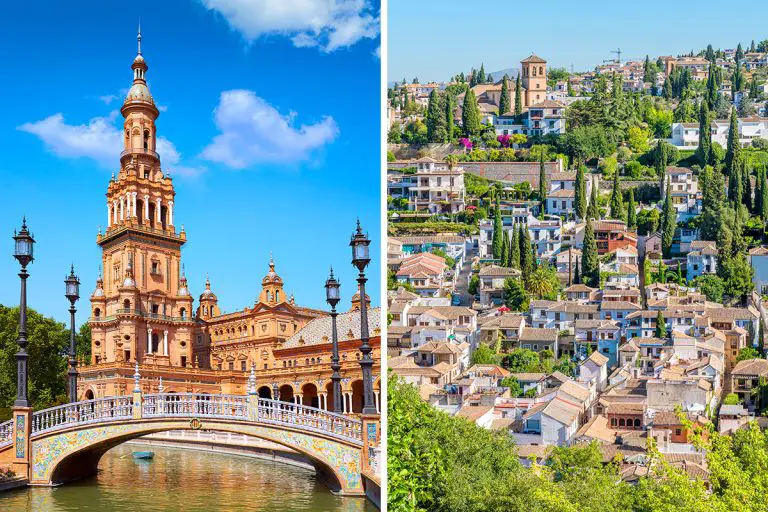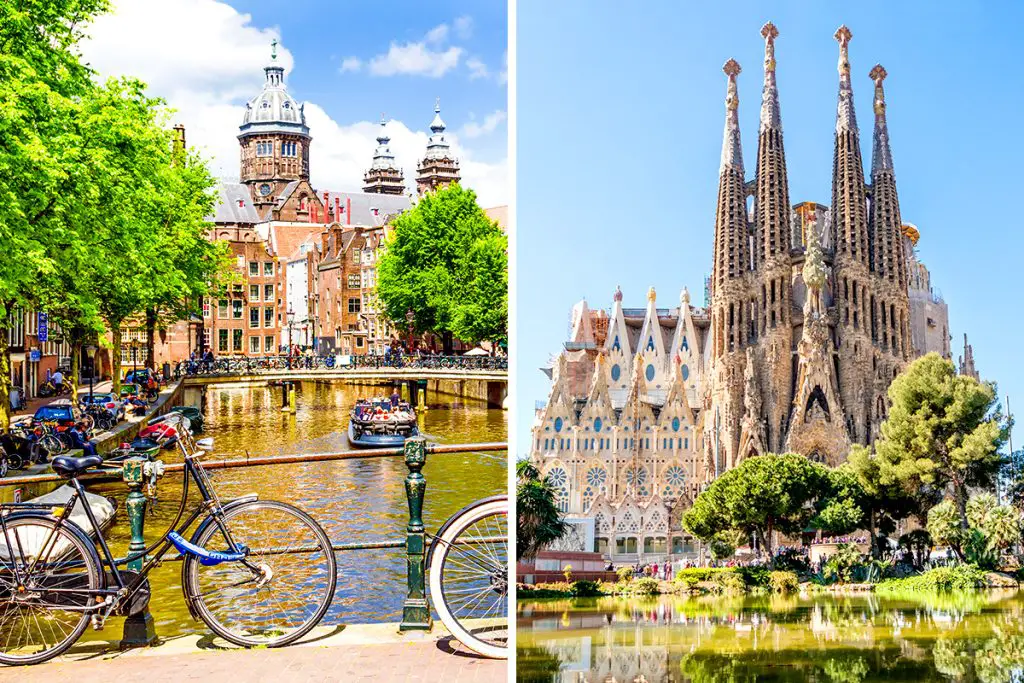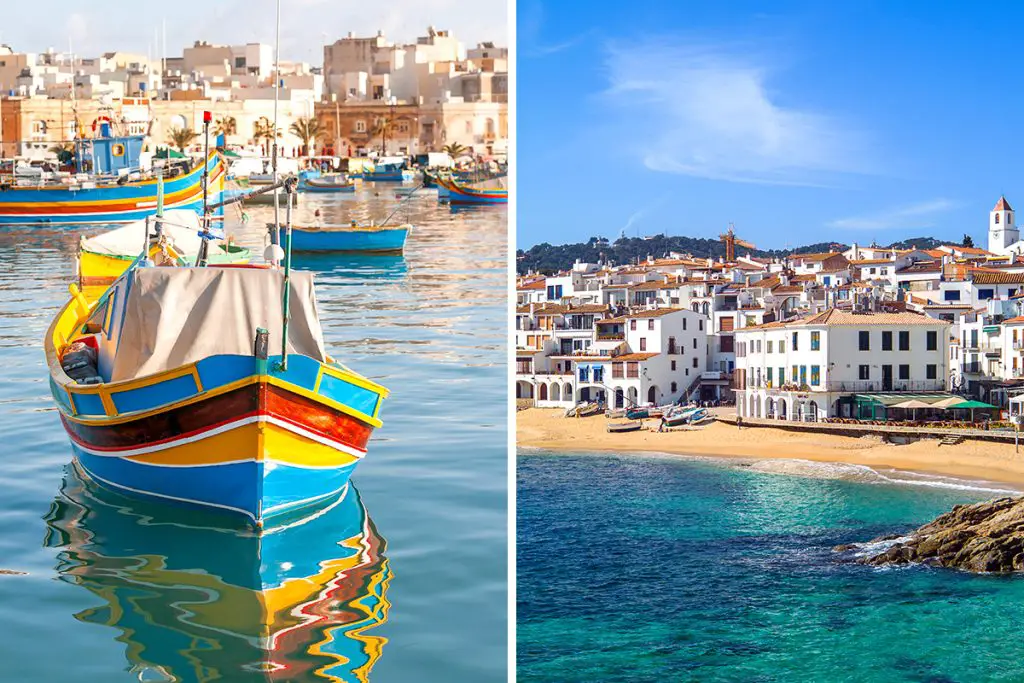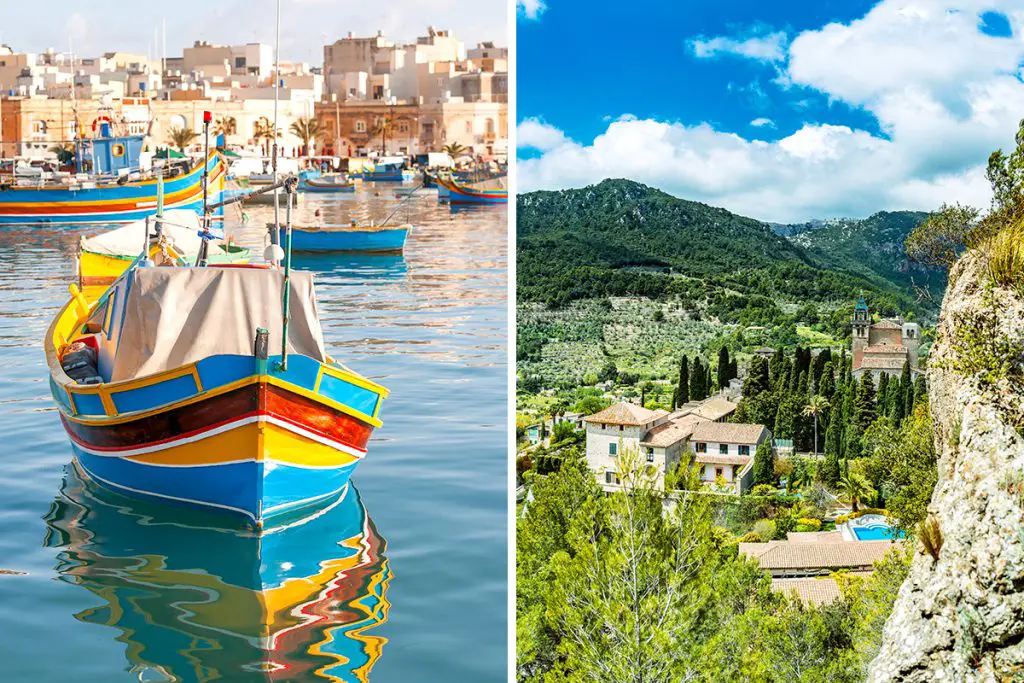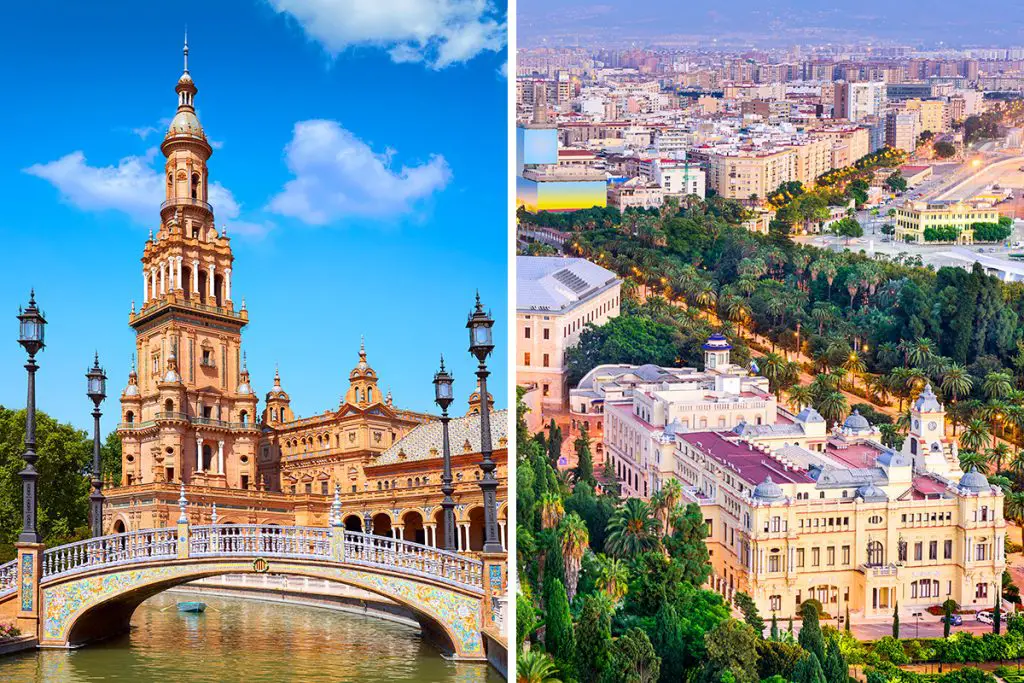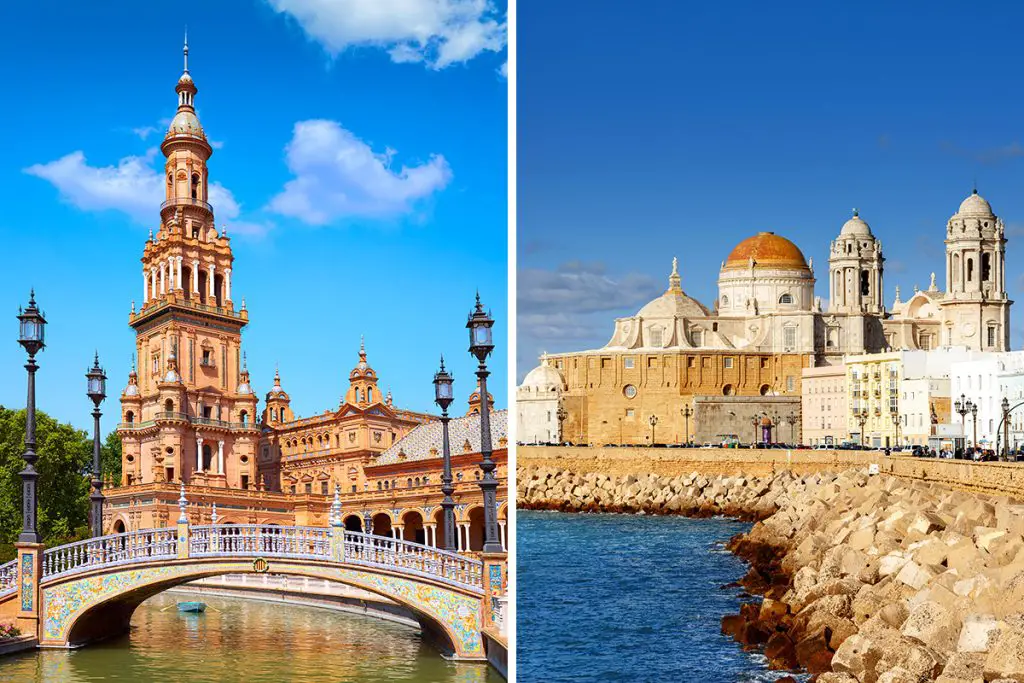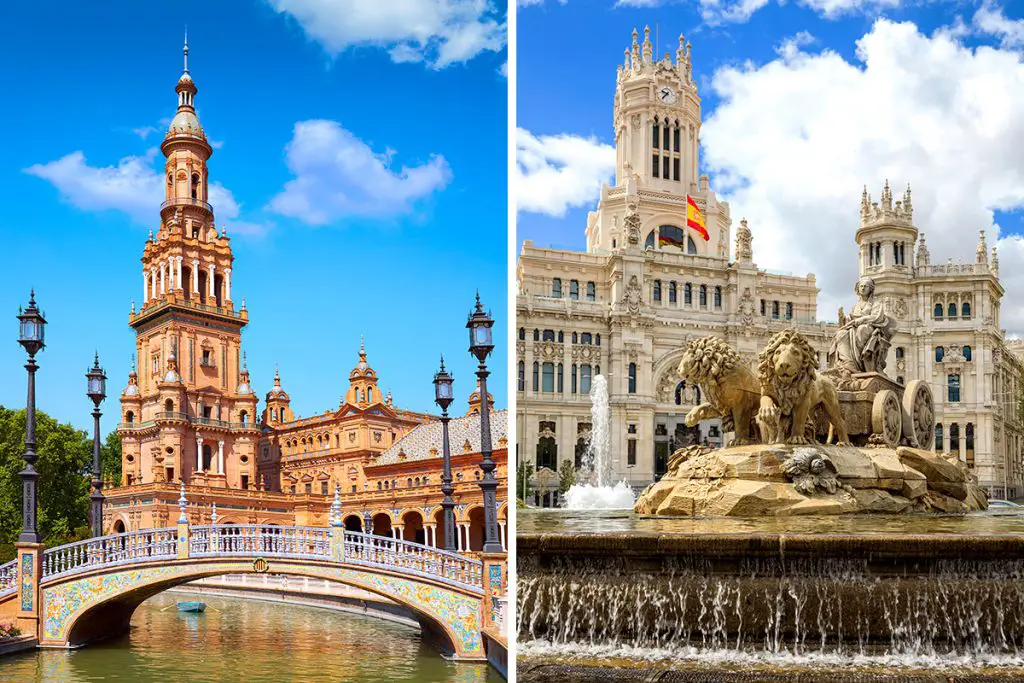It’s never easy to decide when both options are so alluring. Seville offers the flamboyance of Andalusian culture, while Granada provides a serene setting steeped in Moorish history. Intrigued? Stick around, because we’re diving deep into what sets these two cities apart.
History & Culture
In this section, we’re going to unravel the history and culture of Seville and Granada. Both cities sit in Andalusia, the southern region of Spain, but their pasts and present cultural vibes are remarkably different.
Seville, the capital of Andalusia, has been a key city for various civilizations including the Romans and Moors. Its location near the Guadalquivir River made it a significant port city, further enriched during the Age of Exploration.
The city also played a pivotal role in the spread of Christianity in Spain. All these events have led to a rich tapestry of cultural influences that are displayed in its architecture, music, and festivals. Even today, the pulse of history runs through its vibrant streets.
Granada, on the other hand, is known for its significant Moorish influence. Being the last Muslim stronghold in Spain before the Reconquista took over, the city has a rich Islamic heritage. This is most prominently visible in the Alhambra, a hilltop fortress complex.
Beyond its famous landmarks, Granada’s culture feels more introspective and scholarly, perhaps due to its famous university that has been around for centuries.
Despite their differences, both cities celebrate flamenco and bullfighting, traditional Andalusian activities. Yet, the style of these performances varies between the cities. Seville’s flamenco is lively and expressive, whereas Granada’s is more classical and restrained. Bullfighting in Seville tends to be a grand affair, while in Granada it’s more about technique and artistry.
Moreover, Seville’s festivals, such as the Feria de Abril, are large-scale events that highlight its extroverted personality. Granada’s celebrations, however, like the Corpus Christi festival, have a quieter, more traditional tone, focusing on religious and historical aspects.
To summarize, Seville is a melting pot of various cultural influences with an energetic and outgoing spirit. Granada is a city that wears its Moorish history on its sleeve, offering a more introspective experience. Your choice between the two will likely hinge on what type of cultural experience you’re looking to have. So, what’s it going to be?
Attractions & Activities
When it comes to attractions and activities, Seville and Granada each boast a treasure trove of unique experiences. Both cities are chock-full of history, but they offer different ways for you to engage with their past and present. Let’s delve into what sets them apart in this arena.
Seville is renowned for its awe-inspiring landmarks. The Seville Cathedral, for instance, is a marvel of Gothic architecture and is home to the Giralda Tower. A climb up this 100-meter (about 328 feet) tower offers panoramic views that are simply unbeatable. And let’s not forget the Real Alcázar, a palace that’s a blend of Christian and Mudéjar architecture.
As for activities, consider taking a scenic boat ride along the Guadalquivir River or indulge in a flamenco show to immerse yourself in local culture.
Granada’s list of attractions is equally enchanting but decidedly more oriented towards natural beauty and historical exploration.
The Alhambra, a massive fortress and palace complex, offers gardens, fountains, and intricate architectural details that take you back to Spain’s Moorish era. A walk around the Albayzín, the old Muslim quarter, offers narrow winding streets and a sense of stepping back in time.
If you’re more adventurous, the Sierra Nevada mountains offer hiking trails that bring you close to nature.
While Seville leans more toward man-made wonders and lively cultural activities, Granada leans towards the scenic and historical. Seville has more of a “living museum” feel, offering a wide range of experiences that include river cruises and interactive performances. Granada, on the other hand, feels like an actual museum, with its ancient streets and fortress begging to be explored.
In summary, Seville offers a rich blend of historical landmarks and vibrant local experiences, making it ideal for those who love both architecture and lively culture. Granada, meanwhile, captivates with its rich history and natural beauty, providing a peaceful yet educational experience. Both cities have a lot to offer, but your choice will depend on what you prefer: energetic activities and monumental landmarks, or a quieter, more contemplative exploration of history and nature.
Eating, Drinking & Nightlife
When it comes to eating, drinking, and enjoying the night, Seville and Granada offer different yet equally exhilarating experiences. As both cities have strong culinary traditions and lively atmospheres, let’s explore how each one can light up your evenings in its unique way.
Seville is a food lover’s paradise, especially if you’re a fan of tapas. Small plates of jamón serrano, salmorejo, and fried fish are staple items in most bars. The city has a wide array of restaurants ranging from Michelin-starred to cozy family-owned eateries. For something sweet, the orange wine and churros are a must-try.
Drinking in Seville is often a communal event, with locals and tourists mingling in tapas bars. Sangria flows freely, and you can also sample the local sherry. Whether you prefer a bustling plaza or a tucked-away bar, you’ll find the perfect spot to enjoy your drink.
Granada also offers a delightful culinary experience, but it comes with a twist. When you order a drink in most bars, you get a free tapa! You might find yourself enjoying a free plate of patatas bravas or even paella with your cerveza. The flavors here lean more towards Moorish influences, with dishes like lamb tagine making frequent appearances.
The nightlife in Granada is a bit more subdued but equally enjoyable. The city is famous for its teterías, or tea shops, in the Albayzín district. If you’re a fan of the hookah or just want a calming tea before you end your night, this is the place to be.
To sum up, Seville offers a vibrant culinary scene with a wide array of options and a lively drinking culture. Granada, on the other hand, provides a unique tapas experience and offers a more laid-back nightlife. Your preference between the two will depend on whether you want to feast and revel in an effervescent atmosphere or enjoy free tapas in a more relaxed setting.
Shopping
If you’re looking to take home more than just memories, both Seville and Granada offer fantastic shopping experiences, albeit with distinct flavors. So, what should you expect when you hit the shops in these two cities?
Seville offers a blend of tradition and modernity. You’ll find high-end boutiques selling the latest fashions, but you’ll also come across shops that have been around for centuries, selling traditional goods like ceramics and Flamenco attire. Calle Sierpes and Calle Tetuan are the primary shopping streets, where you can find both international brands and local artisan products.
Granada, meanwhile, excels in offering more exotic wares. The Alcaicería, the old Moorish silk market, is a maze of narrow streets filled with shops selling spices, fabrics, and traditional Andalusian crafts. If you’re looking for something truly unique, head to the Albayzín, where small boutiques offer products ranging from handmade leather goods to intricate silver jewelry.
Seville’s shopping scene is vast and sprawling, giving you a little bit of everything, from luxury to tradition. Granada provides a more specialized shopping experience, perfect for those looking for unique and culturally significant items.
In summary, if you want a variety of shopping experiences and are keen on mixing modern with traditional, Seville is your city. If you’re after unique, historically and culturally rich items, Granada will be more up your alley. Both cities offer shopping experiences that are as vibrant and diverse as their histories.
Accommodation
Choosing the right place to stay can make or break your travel experience. When comparing accommodations in Seville and Granada, you’ll find a range of options that cater to different tastes and budgets. Let’s explore what each city has to offer.
Seville’s lodging choices are extensive, from luxurious hotels like Hotel Alfonso XIII to quaint bed-and-breakfasts tucked away in narrow lanes. This city is well-equipped to cater to high-end travelers with its five-star options, complete with rooftop pools and spas.
If you’re traveling on a budget, Seville offers a plethora of hostels and budget hotels, especially near popular tourist areas like Barrio Santa Cruz.
Granada also offers a variety of accommodations but adds a unique touch with cave hotels in the Sacromonte district. These unique dwellings provide an authentic, albeit unconventional, Andalusian experience. Moreover, you can find various mid-range hotels around Plaza Nueva and budget hostels closer to the Alhambra.
Both cities offer apartment rentals, which are a good option if you prefer a homely environment. These are usually fully furnished and come with a kitchen, allowing you to cook meals, an especially handy feature for long stays.
To sum up, Seville offers a wide range of accommodations from luxury to budget, all generally close to major attractions. Granada also offers a variety but adds a unique flair with its cave hotels. Your choice will hinge on whether you want a traditional hotel experience or something a little off the beaten path.
Family-Friendliness & Children’s Activities
When traveling with family, it’s important to consider not just what you want, but also what will keep the kids engaged and happy. Both Seville and Granada are family-friendly destinations, but they offer different kinds of attractions and activities for children.
Seville is a great city for families who love outdoor activities. Parks like Maria Luisa offer expansive green spaces where kids can run around. You’ll also find playgrounds scattered across the city. The Seville Aquarium is a hit with younger children, featuring a wide variety of sea creatures.
Granada also offers a family-friendly environment but in a more educational way. Visits to the Science Park, an interactive museum, are both fun and educational for children. The city’s many plazas also often have street performers and entertainers that captivate kids.
Both cities are known for their seasonal festivals, like Semana Santa and the Three Kings Day Parade. These events are not only culturally enriching but also offer lots of fun activities for children, such as face painting and puppet shows.
In summary, Seville offers more in terms of outdoor activities and is perfect if your kids need room to stretch their legs. Granada is better suited for families looking for a mix of educational and entertaining activities. Both cities, however, are excellent choices for a family vacation and offer a range of activities that kids will love.
Getting There & Getting Around
Whether you’re flying in or navigating the local transportation, understanding how to get to and around Seville and Granada is crucial. Let’s compare these aspects to help you plan your trip more efficiently.
Seville is served by the Seville Airport, which is about 10 kilometers (around 6.2 miles) from the city center. Taxis and buses are readily available for the short journey into town.
Granada, on the other hand, is served by Federico García Lorca Granada-Jaén Airport, about 17 kilometers (approximately 10.6 miles) from the city. While taxis are an option, the airport bus is a budget-friendly way to get into town.
Once in Seville, the bus and tram services are efficient ways to get around. There are also bike rentals and an extensive network of bike lanes. Granada offers a comprehensive bus network and even minibusses that take you up to the hilly areas like the Alhambra and Albayzín. While Seville is more bike-friendly, Granada offers more for those who prefer walking.
In summary, both Seville and Granada have well-connected airports and offer various local transportation options. Seville is more cycle-friendly and has efficient bus and tram services. Granada is better for those who prefer walking and offers a range of bus services that help you explore even its more challenging terrains.
Weather
A trip’s success often hinges on the weather. Both Seville and Granada, located in southern Spain, offer a Mediterranean climate but with some variations that might tilt your preference one way or the other. Let’s look at them month by month.
Seville experiences hot summers with temperatures soaring to around 100°F (38°C) in July and August. If you’re not a fan of extreme heat, you might find these months challenging.
Winters are mild, with temperatures ranging from 50°F to 64°F (10°C to 18°C) between December and February. Spring, from March to May, is a favorable time to visit with pleasant temperatures and minimal rainfall.
Granada is generally cooler than Seville, thanks to its elevation. Summers are less harsh, with temperatures peaking at around 86°F (30°C) in July and August. Winters can get chilly, and snowfall in the nearby Sierra Nevada mountains is common. Expect temperatures to range from 36°F to 55°F (2°C to 13°C) in the winter months.
In summary, Seville offers hot summers and mild winters, making it ideal for those who prefer warmer climates. Granada offers a cooler alternative, especially beneficial in the sweltering summer months. Your choice would depend on what kind of weather you find most comfortable for exploring.
Safety
When traveling, safety should be one of your top concerns. Both Seville and Granada are generally safe cities with low crime rates compared to other European cities. However, there are some differences worth noting.
Seville is a bustling city with a strong police presence, especially in tourist-heavy areas. Pickpocketing can be a concern, particularly in crowded places like markets and festivals. Basic precautions, like keeping an eye on your belongings, are advised.
Granada, while also generally safe, is a smaller city with less of a police presence in comparison to Seville. The city is well-lit, and locals are known to be friendly and helpful. Petty crimes like pickpocketing are less common than in Seville.
Both cities are pedestrian-friendly, which is an added layer of safety when exploring. In Seville, watch out for bike lanes while walking, and in Granada, be mindful of hilly terrains that can be slippery.
In summary, both Seville and Granada are generally safe cities with their unique considerations. Seville has a more visible police presence, but also higher instances of petty crime. Granada offers a quieter, more laid-back atmosphere with fewer safety concerns.
Cost
While both Seville and Granada offer experiences that are priceless, it’s important to consider your budget when planning a trip. Costs can vary greatly between these two destinations, especially when it comes to food, lodging, and transportation.
In Seville, you can expect to pay around $136 to $151 per night for a mid-range hotel. A meal at a moderate restaurant would cost about €20 to €40 (around $24 to $48). Buses and trams are fairly priced at around €1.40 (approximately $1.70) for a single journey.
Granada is generally more budget-friendly. Mid-range hotels would set you back $127 per night. A comparable meal in Granada would cost you €52 (approximately $56). Public transport is also slightly cheaper at €1.20 (about $1.40) for a single bus fare.
In summary, Granada tends to be somewhat pricier but offers a range of experiences that might justify the cost. Seville provides a more budget-friendly alternative without skimping on the quality of your stay. But there really is no definitive difference. The choice ultimately depends on what you’re looking to get out of your trip and how much you’re willing to spend.
Which Is Better – Seville or Granada?
Choosing between Seville and Granada for your next trip is like deciding between two flavors of your favorite ice cream—each offers something unique, yet both promise a delightful experience. Now, it’s time to sum up all we’ve discovered about these two marvelous Spanish cities in various aspects.
In terms of history and culture, Seville offers a rich tapestry that includes Moorish influences, flamenco history, and a sense of cosmopolitan flair. Granada, on the other hand, gives you the chance to dive into a fascinating blend of cultures, most notably showcased by the awe-inspiring Alhambra. Both cities are rich in history but provide different atmospheres.
When it comes to attractions and activities, Seville offers more urban experiences and iconic landmarks like the Plaza de España. Granada counters with a more laid-back vibe, featuring historic sites and natural beauty, notably the Sierra Nevada mountains. Your pick here depends on whether you prefer bustling city life or a mix of urban and natural attractions.
Beaches aren’t the main draw in either city, but both offer feasible day trips to the coast. Seville has the advantage of being closer to a variety of beach destinations, while Granada offers proximity to fewer but more tranquil options. Consider what type of beach experience you’re after.
If you’re keen on eating, drinking, and nightlife, Seville has a more vibrant scene with a broad range of options. Granada tends to be more low-key but offers unique experiences like free tapas. It boils down to whether you want a lively night out or a quieter, more intimate evening.
Shopping in Seville offers a mix of modern and traditional options, with a more expansive range of stores. Granada offers a more boutique experience, often at a lower price point, especially in the Albaicín and Realejo districts.
Accommodation options are plentiful in both cities, with Seville leaning towards more luxurious options and Granada offering a broader range of budget-friendly stays. Family-friendliness and children’s activities are abundant in both, but Granada’s smaller size may make it easier for families to get around.
Speaking of getting around, both cities have efficient public transportation systems, with Seville offering a bit more in terms of variety. The weather is more or less similar but depends on your tolerance for heat.
Both cities are generally safe, with Seville having a slightly higher but still low crime rate. Lastly, Granada is a bit pricier than Seville, emphasis on a bit.
In summary, Seville is for you if you crave a more cosmopolitan experience and love vibrant city life. Choose Granada if you’re looking for a more relaxed vacation with a deep dive into history and natural beauty. Regardless of your choice, both cities promise an unforgettable Spanish experience.

